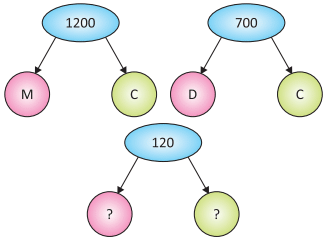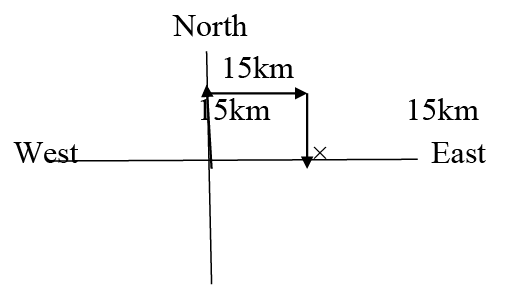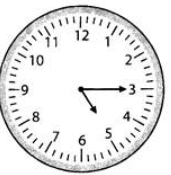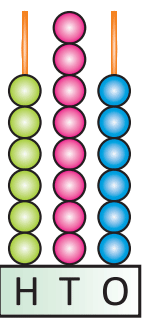Maths Olympiad Previous Year Paper -1 | Mathematics Olympiad Class 4 PDF Download
| Table of contents |

|
| Logical Reasoning |

|
| Mathematical Reasoning |

|
| Everyday Mathematics |

|
| Achievers Section |

|
Note: The questions provided in this document are similar to the questions that were asked in the actual Olympiad exam. So, we recommend you study these for your Olympiad preparation
Logical Reasoning
Q1: Veer is in a line. If he is 6th from the front and 12th from the back, how many people are there in total in the line?
(a) 20
(b) 17
(c) 19
(d) 18
 View Answer
View Answer 
Ans: (b)
- To find the total number of people in the queue, we can add Veer's position from the front and his position from the back, then subtract 1 (since Veer is counted in both positions).
- So, the calculation is: 6 (from the front) + 12 (from the back) - 1 = 17.
- This means there are a total of 17 people in the queue.
- Thus, the correct answer is 17.
Q2: Find the combination of numbers so that the given letters are arranged accordingly to form a meaningful English word.
K A T R M E
(a) 5, 2, 4, 1, 6, 3
(b) 5, 2, 1, 4, 6, 3
(c) 3, 4, 6, 2, 1, 5
(d) 4, 2, 3, 1, 6, 5
 View Answer
View Answer 
Ans: (a)
- The letters K, A, T, R, M, E can be rearranged to form the word "MARKET".
- Using the combination 5, 2, 4, 1, 6, 3 corresponds to the letters M, A, R, K, E, T respectively.
- This arrangement gives us a meaningful English word, which is "MARKET".
- Other combinations do not yield a valid English word when the letters are rearranged.
Q3: Observe the pattern of numbers given:
Which pair of the given Roman numerals must fill the blank spaces?
(a) C, M
(b) C, X
(c) D, C
(d) C, L
 View Answer
View Answer 
Ans: (b)
120 = 100 + 10 + 10 = C, X
Q4: Four of the following five are alike in a certain way, and so form a group.
Which is the one that does not belong to that group?
(a) QO2
(b) PN2
(c) TR2
(d) HF2
 View Answer
View Answer 
Ans: (a)
Only option (a) has vowel.
Q5: In the following question, select the missing number from the given series.
23, 11, 34, 45, 79,?
(a) 121
(b) 124
(c) 163
(d) 169
 View Answer
View Answer 
Ans: (b)
23+11=34
11+34=45
34+45=79
45+79=124.
Q6: Which word will appear first when arranged in order of dictionary?
(a) Ankle
(b) Anger
(c) Antique
(d) Aster
 View Answer
View Answer 
Ans: (b)
Order in which they will appear in dictionary will be Anger, Ankle, Antique, Aster.
Q7: In a certain code language, "RUN" is written as "28", and "BUS" is written as "39”. How is "GUN" written in that code language?
(a) 37
(b) 38
(c) 39
(d) 42
 View Answer
View Answer 
Ans: (c)
Add the ranking of opposite letters of the word , RUN which is IFM
= 9 + 6 + 13 = 28
Similarly, BUS=25+6+8=39
Hence, GUN=20+6+13=39
Q8: Suman walks 15 km towards the north. She turns right and walks another 15 km. She turns right and walks another 15 km. In which direction is she from her starting point?
(a) North
(b) South
(c) East
(d) West
 View Answer
View Answer 
Ans: (c)
Q9: If the given clock is 45 minutes slow, then the CORRECT time after half an hour will be ______ (a) 6 O'clock
(a) 6 O'clock
(b) 6: 30
(c) 7 O'clock
(d) 5: 30
 View Answer
View Answer 
Ans: (b)
Time shown on the clock is 5: 15 Since, clock is 45 minutes slow, so the correct time will be 6'Oclock. Time after half an hour will be 6 : 30.
Q10: A series is given with one term missing. Select the correct alternative from the given ones that will complete the series.
AB, CD, EF, GH,?
(A) HJ
(B) HK
(C) IJ
(D) JI
 View Answer
View Answer 
Ans: (c)
English Alphabet series Next two letters after H.
Mathematical Reasoning
Q11: Aman went on a 15-day journey. He stayed for 7 days in Manali and the remaining days in Shimla. What portion of his trip did he spend in Shimla?
(a) 8/7
(b) 7/8
(c) 8/15
(d) 7/15
 View Answer
View Answer 
Ans: (c)
- Aman's total trip duration = 15 days.
- He spent 7 days in Manali.
- Days spent in Shimla = 15 - 7 = 8 days.
- The fraction of the trip spent in Shimla = 8 days out of 15 days = 8/15.
So, the correct answer is 8/15.
Q12: A string is 40 m long. A piece measuring 800 cm is cut from it. The remaining piece is then cut into 10 equal pieces. Find the length of each piece.
(a) 320 cm
(b) 350 cm
(c) 400 cm
(d) 410 cm
 View Answer
View Answer 
Ans: (a)
- First, convert the total length of the string from meters to centimeters:
40 m = 4000 cm. - Next, subtract the length of the piece cut from the string:
4000 cm - 800 cm = 3200 cm remaining. - Now, divide the remaining length by the number of equal pieces:
3200 cm ÷ 10 = 320 cm. - Thus, the length of each piece is 320 cm.
Q13: Priya had 500 stickers. After giving 150 stickers to her brother, what fraction of the total stickers remain with her?
(a) 5/7
(b) 3/10
(c) 7/10
(d) 7/9
 View Answer
View Answer 
Ans: (c)
- Initial number of stickers: Priya had 500 stickers.
- Stickers given away: She gave away 150 stickers.
- Remaining stickers: stickers
- Fraction of stickers left: 350/500
- Simplifying the fraction:

Thus, the fraction of stickers left is 7/10.
Q14: In January, 4105 children went to the zoo, and in February, 2534 children visited. What is the total number of children who visited the zoo in these two months?
(a) 6548
(b) 6639
(c) 6670
(d) 6234
 View Answer
View Answer 
Ans: (b)
- Add the number of children from both months:
Children in January: 4105
Children in February: 2534 - Calculate the total: 4105 + 2534 = 6639
Thus, the total number of children who visited the zoo in January and February is 6639.
Q15: Preeti purchased a piece of cloth that has four equal sides. What shape could this cloth be?
(a) Square
(b) Rectangle
(c) Triangle
(d) None of these
 View Answer
View Answer 
Ans: (a)
- The cloth has four equal sides, which means it is a square.
- A rectangle has opposite sides that are equal, but not all four sides are equal.
- A triangle has only three sides, so it cannot be the shape of the cloth.
Therefore, the correct shape of the cloth is a square.
Q16: Shreya purchased 86 kg 475 g of sugar, while Puneet acquired 79 kg 825 g of sugar. Who purchased a smaller amount of sugar, and by what margin?
(a) Shreya, 6 kg 650 g
(b) Puneet, 6 kg 650 g
(c) Shreya, 7 kg 350 g
(d) Puneet, 7 kg 350 g
 View Answer
View Answer 
Ans: (b)
- To determine who bought less sugar, we need to compare the total amounts.
- Shreya's sugar: 86 kg 475 g = 86475 g
- Puneet's sugar: 79 kg 825 g = 79825 g
- Puneet bought less sugar. The difference is 86475 g - 79825 g = 6650 g, which is 6 kg 650 g.
Q17: In which of the following options is seven not in the hundreds place?
(a) 2790
(b) 3578
(c) 4789
(d) 5785
 View Answer
View Answer 
Ans: (b)
The hundreds place is the third digit from the right in a number.
- In 2790, the hundreds place is 2.
- In 3578, the hundreds place is 5, so 7 is not in the hundreds place.
- In 4789, the hundreds place is 4.
- In 5785, the hundreds place is 5.
Thus, the only option where 7 is not in the hundreds place is 3578.
Q18: A city has a population of 92582. Round off the population to the nearest hundreds.
(a) 92500
(b) 92600
(c) 93500
(d) 92580
 View Answer
View Answer 
Ans: (b)
To round 92582 to the nearest hundred:
- Look at the tens digit (which is 8).
- Since 8 is 5 or more, we round the hundreds digit 5 up to 6.
- Therefore, 92582 rounds up to 92600.
The correct rounded number is 92600.
Q19: Kanika has 4 photo albums. In each album, there are 10 pages. If there are 5 photos on each page, then how many total photos are there in all albums?
(a) 200
(b) 150
(c) 100
(d) 180
 View Answer
View Answer 
Ans: (a)
- To find the total number of photos, first calculate the total number of pages across all albums:
4 albums × 10 pages = 40 pages. - Next, determine the total number of photos by multiplying the total pages by the number of photos per page:
40 pages × 5 photos = 200 photos. - Thus, the total number of photos in all albums is 200.
Q20: Which Roman numeral is greatest?
(a) DCLX
(b) CDXL
(c) DCXL
(d) CDXX
 View Answer
View Answer 
Ans: (a)
DCLX = 500 + 100 + 50 + 10 = 660
CDXL =(500-100) + (50-10) = 440
DCXL = 500 + 100 + (50- 10) = 640
CDXX =(500-100) + 10 + 10 = 420
Everyday Mathematics
Q21: The smallest 6-digit number is ...............
(a) 1,11,111
(b) 1,00,001
(c) 1,10,010
(d) 1,00,000
 View Answer
View Answer 
Ans: (d)
Smallest 6-digit number is 1,00,000.
Q22: Which of the following is equivalent to “five lakhs one hundred nine”?
(a) 50109
(b) 501009
(c) 500109
(d) 510090
 View Answer
View Answer 
Ans: (c)
Five lakh one hundred nine = 5,00,109.
Q23: From which Roman numeral, apart from V, can I be subtracted?
(a) I
(b) X
(c) L
(d) C
 View Answer
View Answer 
Ans: (b)
As, = 10 – 1 = 9
Therefore,
I can be subtracted from X.
Q24: 10 less than 100 is written as:
(a) XV
(b) XC
(c) CX
(d) LX
 View Answer
View Answer 
Ans: (b)
XC = 100 - 10 = 90
Q25: Compare and fill the box with the appropriate symbol.  (a) >
(a) >
(b) <
(c) =
(d) None of these
 View Answer
View Answer 
Ans: (a)
VI = 6 and IV = 4 So, 6 > 4
Q26: Compare and fill the box with the appropriate symbol.  (a) >
(a) >
(b) <
(c) =
(d) None of these
 View Answer
View Answer 
Ans: (b)
CCCXXIV + CCLXIX = 324 + 269 = 593 and DCCLII – CLVI = 752 – 156 = 596
So, 593 < 596
Q27: Number 75 is written as:
(a) LXV
(b) LXXV
(c) CXV
(d) LVV
 View Answer
View Answer 
Ans: (b)
75 = 50 + 10 + 10 + 5 = LXXV
Q28: Which Roman numeral represents the greatest three-digit number?
(a) IXIXIX
(b) CMIXIX
(c) CMXCIX
(d) CMIIC
 View Answer
View Answer 
Ans: (c)
The greatest 3-digit number is 999.
999 = 900 + 90 + 9 = (1000 - 100) + (100 - 10) + (10 - 1) = CMXCIX
Q29: Write the expanded notation for 3,00,123:
(a) 300000 + 100 + 20 + 3
(b) 300000 + 00000 + 0000 + 20 + 3
(c) 300000 + 1000 + 20 + 3
(d) 300000 + 10000 + 20 + 3
 View Answer
View Answer 
Ans: (a)
Expanded form of 3,00,123
= 3 × 100000 + 0 × 10000 + 0 × 1000 + 1 × 100 + 2 × 10 + 3
= 300000 + 0 + 0 + 100 + 20 + 3
= 300000 + 100 + 20 + 3
Q30: What number is 1000 more than 69,090?
(a) 79,000
(b) 70,900
(c) 70,090
(d) 70,009
 View Answer
View Answer 
Ans: (c)
1000 more than 69,090 = 69,090 + 1000 = 70,090
Achievers Section
Q31: Sandhya’s user ID is a 5-digit number. In which, ‘9’ is in the ten thousand place, ‘0’ is in the ones place, ‘8’ is in the thousands place, ‘4’ is in the tens place and ‘2’ is in the hundreds place. What is her user ID?
(a) 90,842
(b) 98,240
(c) 89,204
(d) 98,420
 View Answer
View Answer 
Ans: (b)
9 at (Ten Thousands Place)
0 at (Ones Place)
8 at (Ten Thousands Place)
2 at (Hundreds Place)
4 at (Tens Place)
So, required 5-digit number is 98240.
Q32: How many beads should be removed from the tens place and hundreds place in the abacus shown here if it has to represent the number 28 tens less than the number shown in the abacus?
(a) 2, 2
(b) 8, 2
(c) 2, 1
(d) 3, 0
 View Answer
View Answer 
Ans: (b)
Abacus shows the number = 686
28 tens (280) less than the number shown on abacus = 686 – 280 = 406
So, we need to remove 8 beads from tens place and two beads from hundreds place.
Q33: What is the difference between the greatest and the least three-digit numbers formed by using X, L, C and D?
(a) DCXL
(b) DCLX
(c) CDXL
(d) CCXX
 View Answer
View Answer 
Ans: (d)
The greatest number = DCLX = 660
The least number = CDXL = 440
Difference = 660 – 440 = 220 = CCXX
Q34: Choose the correct option from the following.
(a) 516 < DCVI
(b) 256 = CCLVII
(c) 408 ≠ CDVIII
(d) 1005 > MD
 View Answer
View Answer 
Ans: (a)
(a) DCVI = 500 + 100 + 5 + 1 = 606 > 516
(b) CCLVII = 100 + 100 + 50 + 5 + 1 + 1 = 257 ≠ 256
(c) CDVIII = (500 – 100) + 5+ 1 + 1 + 1 = 408 = 408.
(d) MD = 1000 + 500 = 1500 > 1005
Q35: If the second smallest 5-digit even number is formed by using all the digits 9, 2, 0, 4 and 3, then the digit in the ten thousand place stands for .................. hundreds.  (a) 204
(a) 204
(b) 240
(c) 200
(d) 203
 View Answer
View Answer 
Ans: (c)
Smallest 5-digit even number formed by 9, 2, 0, 4, 3 = 20394
Second smallest 5-digit even number formed by 9, 2, 0, 4, 3 = 20934
So, the digit in the ten thousands place stands for 200 hundreds.
|
33 videos|98 docs|48 tests
|
FAQs on Maths Olympiad Previous Year Paper -1 - Mathematics Olympiad Class 4
| 1. What types of questions can I expect in the Maths Olympiad for Class 4? |  |
| 2. How can I prepare effectively for the Maths Olympiad? |  |
| 3. Are there any specific topics I should focus on for the Class 4 Maths Olympiad? |  |
| 4. What is the scoring pattern for the Maths Olympiad exam? |  |
| 5. How important is time management during the Maths Olympiad exam? |  |
















